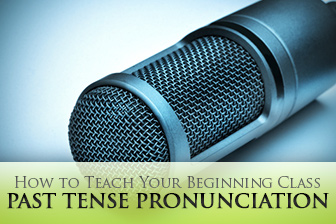Get it? Got it? Good! 4 Essential Keys to Teaching Your Beginning Class Past Tense Pronunciation


It's critical to be sensitive to the needs of every individual as well as to devise practical and memorable pronunciation lessons and solutions. Examine these 3 secrets to target problematic pronunciation and learn how to combat common issues before they materialize.

Have you ever seen actors or singers warm up their vocal chords? They do some pretty funny stuff to stretch out their lungs, exercise their lips and jaw, and relax facial muscles. There is great method to their madness which you can tap into for ESL learners. This type of practice can be amusing but also very effective to battle pronunciation intimidation or self-consciousness. There are many ways you can utilize these warm-up activities. You could perform some vocal chord exercises, jaw relaxations, and pointed practice on particular sounds. The students can then practice them on their own or together with you in class. These exercises can be done on the spot anytime you want to loosen up the mood and do pronunciation practice. This type of activity works really well because it light-hearted and allows students to make some noise and put inhibitions aside.
If you would like some inspiration how to bring this into your classes, there are several You Tube videos that can help you learn the best exercises and sounds to utilize. One specific resource is an educator named Marsha Chan. She has created several videos on You Tube that you and your students could benefit from watching and imitating. She makes the exercises fun while also providing explanations and useful practice. Marsha inspires you to think about how we use our mouth, lips, jaw, and vocal chords to make sound. You can easily use her exercises as a jumping off point to create your own. This type of pronunciation work is targeted and memorable. Once you refine your process of how and when to do some of these warm-ups, students will be begging for more!
Sharpening correct pronunciation of similar sounds is essential for learners to develop clear speech. Providing guidelines of which consonants are voiced and which are voiceless is an important first step. Voiced consonants create a vibration in the vocal cords. You can feel voiced sounds where they are produced, at the neck. Voiceless consonants are the opposite of voiced, and do not create any vibration in the vocal chords. To demonstrate voiceless sounds, students put fingers of one hand on their throat, and the other hand in front of their mouth. If they feel a heavy breath, but no vibration, it is a voiceless sound. An alternative to this is to put a piece of paper in front of the mouth. The paper should move when the sound is voiceless. Sometimes it can be a bit tricky for students to feel or not feel the vibration, so have them loudly and clearly produce the sounds so they can determine whether each sound is voiced or voiceless.
There are many more voiced sounds than voiceless. Here is the list of letters that are voiced and voiceless:
VOICED: b, d, g, j, l, m, n, r, v, w, y, z, th
VOICELESS: f, h, k, p, s, t, ch, sh, th
When working on these sounds, it is quite common to use a pair of opposites to really drive the point home. The pairs are often the commonly confused sounds anyway, so it is only natural to work on them together to punctuate the differences. Common pairs are k/g, b/p, l/r, and s/z. Also th has both a voiced and voiceless component. To practice these, choose words that you can compare. For example, use the sentence: Think about this thing, that thing, and those things. In general, the voiced th sound occurs in a lot fewer words than the unvoiced th. However the voiced th sounds occurs a lot in small words like the, that, these, their, and them.
It might sound crazy but Nursery Rhymes provide an unlimited supply of simple, quick pronunciation work. They can be nonsensical, often focus on specific sounds, and inherently have rhymes that assist with language development. You can find all the resources you need on the internet. Students are often curious about the meaning behind nursery rhymes as well, so you could explore the nonsense, or use them to increase vocabulary and explain concepts. A few examples of songs that are easy to learn and have great language value are: Hey Diddle Diddle, Pop Goes the Weasel, and Mary Had a Little Lamb. They are repetitive, often rhyme and have catchy and memorable melodies. Some of the other songs like Itsy Bitsy Spider, I'm a little Teapot, and the Wheels on The Bus can also be combined with hand motions for younger learners or adults who are open to being a bit animated.
In fact healthy pronunciation practice should be exaggerated, loose, and full of sound. Try the above three secrets to keep your students engaged and excited about pronunciation work.